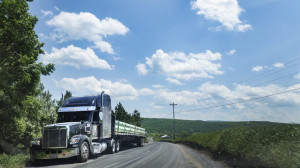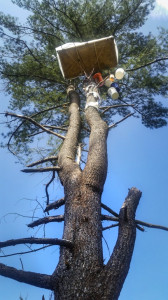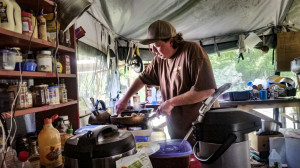Above photo: Pipeline fighters in tree-sits occupy the remaining white pines on the Gerhart’s land. Photo by Mark Scialla
NOTE: The Gerhart’s lost their recent court case and are concerned that the police will come onto their land and remove their tree sit. Please take action to support them:
1. Write to the local Sheriff to urge him to protect the Gerhart family and land, not the oil companies. Email your letter to Sheriff Leonard at [email protected].
2. Send donations to Camp White Pine PA. Here is their request:
Camp White Pine will not be deterred by the recent injunction. Our tree sit continues!
We are asking for help in getting donations and supplies to camp. We have broken up our asks into specific categories. Also, if you know of coalitions or organizations who donate, please share relevant lists with them.
If you’d rather donate to the Camp White Pine legal fund, you can do so at fundrazr.com/campwhitepine
Shipping Address:
CWP Inc.
P.O. Box 551
Huntingdon, PA 16652
CAMP NEEDS LISTS
Ad Hoc
https://www.amazon.com/hz/wishlist/ls/2SRF4POCX0EZA
Climbing Gear
https://www.amazon.com/hz/wishlist/ls/1R8D6M9QT1OW0
Food & Water
https://www.amazon.com/hz/wishlist/ls/2NNO1BFFR88PX
Medical
https://www.amazon.com/hz/wishlist/ls/28AO4VH5DPDAH
Risk Mitigation Gear
https://www.amazon.com/hz/wishlist/ls/2VNY82UHBR4GJ
Technical
https://www.amazon.com/hz/wishlist/ls/FL5NAEO272XB
Last spring, Elise Gerhart and her mother Ellen heard chainsaw motors revving in the woods behind their southern Pennsylvania home. Pipeline workers had returned to finish clear-cutting a patch of the Gerhart’s 27-acre forest. The two women, joined by other activists, raced into the woods, and Elise climbed 40-feet high into a 100-year-old white pine. Cutting that tree would have brought her down with it. The workers were forced to stop.
A year later, only three of the hundreds of trees remain in a three-acre clearing of stumps and logs. Forts suspended from the branches of these trees block new work in the woods. It was last year that the Gerharts first put out a call for help to stop a natural gas liquids project planned to pass under a wetland and forest on their property in Huntingdon County. The Gerhart’s land, now known by activists as Camp White Pine, has since become another front in the handful of pipeline battles occurring across the continent, many of which were inspired by the movement against the Dakota Access Pipeline last year.
The battle over the Gerhart’s land is part of the national debate over energy and fossil fuels. Pennsylvania voters supported President Trump’s agenda to revive the coal industry, expand fracking and natural gas infrastructure, but by a narrow margin of less than 50,000. President Trump’s energy agenda is lauded in a region that has lagged the nation in post-recession recovery. But some state residents suspect their water has been contaminated by fracking, and families concerned about the danger of increased energy production are standing off in town halls and local courts against the energy industry.
After Ellen Gerhart and her husband bought their land in 1983, they enrolled in a state conservation program and made a commitment to not develop the forest.
“The health issues from fossil fuels or the environmental damage from leaks or installation — that starts from the get go,” said Ellen Gerhart, a 62-year-old retired special education teacher who takes karate three nights a week and considers “The Art of War” “required” reading. “If you take the money, you’re saying, ‘OK, we’ll take the money and you take the environment.’ And there is a part of me that just can’t do that.”
The project cutting through the Gerhart’s property is Mariner East II, a 350-mile-long expansion to a series of pipelines that would carry natural gas liquids from the Utica and Marcellus Shale plays in West Virginia, Pennsylvania and Ohio to be processed and exported near Philadelphia. Sunoco Logistics, the developer building the pipeline, needs three acres of the Gerhart’s land. But the family won’t allow it.
Sunoco Logistics is using eminent domain to build on the Gerhart’s land despite the opposition. In Pennsylvania, pipeline companies are regulated like public utilities, meaning they can take private property for projects as long as they provide a public good. Mariner East II was initially planned to export natural gas liquids to Europe, but after a 2014 lower court ruling questioned the project’s benefit to Pennsylvanians, Sunoco added two propane terminals in the state. The company says the additional propane terminals are necessary to meet new market demand.

A truck carrying pipe for the Mariner East 2 project idles on the road near Camp White Pine. Photo by Abbey Oldham
“This need was demonstrated during the polar vortex of 2013-2014 when there were propane shortages throughout the northeast, including Pennsylvania,” Jeffrey Shields, a Sunoco Logistics spokesperson said.
Shields also said the company plans to ship ethane to a power generation facility in Cambria County, Pennsylvania, that is slated to be operational by 2019. Two courts have upheld Sunoco’s authority to invoke eminent domain.
Governments often use eminent domain for highways, buildings or other projects intended for public use. But state and federal regulators can grant eminent domain use to private companies. Pipeline developers were first authorized to use eminent domain just before the U.S. entered World War II. That never changed after the war ended.
People at Camp White Pine are young and scruffy and prefer the country to the city. Dusty and smelling like pine sap, they wear camouflage hats, work boots, overalls and bandanas on their faces. They use aliases instead of real names. Most avoid cameras and interviews to hide their numbers and identities. They say they have good reason — documents leaked to The Intercept showed the pipeline company used a private security firm with a background in counterterrorism to monitor resistance to the Mariner East II system.
Resistance to Mariner East II has drawn people from across the country to support the Gerharts. Some at Camp White Pine are veterans of other pipeline fights. They see the camps as part of a broader struggle to defend the environment and the rights of rural and indigenous people.
Josh Michener, also called “Turtle,” is the camp cook. He prepares meals from food that’s donated or dumpstered. He’s cooked at kitchens in Standing Rock and six other pipeline resistance camps around the country since leaving his Idaho home in November. “The real reason I’m doing this is that I have an 11-year-old daughter,” Michener said. “I don’t want her to have to pay for water at a pump like gasoline.”
In each of the three trees hangs a wooden fort with a tarp roof. The platforms sway lightly with movement or strong wind. Getting up the tree requires a wobbly 10-minute climb up a thin rope. Inside is just enough room for two to sleep facing east above the forest canopy. Each tree-sit is connected to the other by traverse lines for transporting food, supplies and people. If one tree were to be cut down, it would rip a sitter in another tree to the ground. Food and books are stockpiled to wait out a police siege, and the bases of the trees are wrapped in chicken wire to thwart chainsaws. From their perch, the protesters watch over the woods, an ear to the workers’ radios and an eye on construction about a half-mile away.
In 2015, the Gerharts refused a cash offer from Sunoco. The company took control of their land anyway. They’ve grappled with the company in court ever since. Last month, a judge denied their appeal against Sunoco’s use of eminent domain. The last legal hope is an appeal to the state Supreme Court.
“If you don’t stand up against bullies, they keep on doing what they’re doing,” Ellen Gerhart said.
When the workers first came to open the forest, they found Elise and her allies dangling from the tree branches. They cut around the tree-sitters instead, clearing most of the three acres. Ellen Gerhart says she and two others were arrested while warning about the danger of cutting too close to her daughter in the tree. They were charged with disorderly conduct. One person was held on $200,000 bail.
The company and police came back a week later and without notice. Elise, Ellen and their allies tried again to stop them. In a repeat of the previous week, Elise was in a tree, the workers couldn’t finish and the police charged Elise’s mom and one other, and later Elise, with contempt of a court order. Ellen says she was placed in isolation for three days with no contact to a lawyer, according to her public comment to Pennsylvania’s Department of Environmental Protection. All charges were later dropped. This past April, Huntingdon County Judge George Zanic granted Sunoco Logistics a “writ of possession,” which enables it to have the Gerharts arrested for trespassing on their own property. On Thursday, Zanic ordered the family and other activists off the easement.
Pennsylvania is one of several states where lawmakers are looking to up the penalties for pipeline fighters. Sen. Scott Martin is seeking co-sponsors for a bill that would pass law enforcement response costs onto protesters if they are convicted for rioting or demonstrating. Martin represents Lancaster County, where an action camp on private property was built in the path of the Atlantic Sunrise pipeline. In May, he invited North Dakota officials who policed the anti-Dakota Access Pipeline movement to brief Lancaster County first responders on preparing for protests.
And in April, state Sen. Mike Regan introduced a bill that would make it a felony to trespass onto oil, gas and other infrastructure facilities with the intent to damage or disrupt. A conviction would carry two years in prison and a minimum $10,000 fine, which would apply also to anyone conspiring to trespass. More than a dozen states have recently introduced legislation targeting mass protests. Bills in Colorado, South Dakota, North Dakota and Oklahoma were drafted in response to oil and gas infrastructure protesters.
For two years, the Gerharts have stood against Sunoco. They say the pipeline is dangerous for them and the environment. “We started really doing some research on this company and on the product it was carrying,” Ellen Gerhart says. “The more research you do, the worse the picture gets.”
Natural gas liquids are byproducts of oil and natural gas production. They include propane, butane, ethane and pentane, which are used for heating and cooking, fuel blends or plastics. Like natural gas, they are also poisonous and explosive. A leak could create a fireball or an invisible, odorless cloud of deadly vapor that can travel for miles. The Gerharts don’t want to take a chance. Their home is about 200 feet from Mariner East II’s path.
Pipelines are safer than transporting fossil fuel products by rail or road. But when accidents do occur they can be disastrous. Not long after the Gerhart’s last confrontation with Sunoco, a Spectra Energy natural gas line exploded in northeastern Pennsylvania, blowing out a 12-foot deep and 1,500-square-foot crater. It torched 40 acres and left a 26-year-old man with third degree burns on more than 75 percent of his body. Sunoco Logistics has one of the worst records for oil spills among pipeline companies, a Reuters analysis found.
Energy Transfer Partners, the parent company of Sunoco Logistics, developed the Rover Pipeline in Ohio. It leaked more than two million gallons of drilling fluid into a wetland in April. The Dakota Access Pipeline also leaked before going online.
Shields says those spills resulted in little to no harm to the public, and that the Mariner East II project meets or exceeds federal safety regulations.
“We continually work to ensure and improve the safety of our pipeline systems, and Mariner East includes multiple layers of safety to protect our neighbors, our workers and the environment,” Shields said in an email, adding, “The Mariner East II project is strictly regulated for safety by both the U.S. Department of Transportation and the Pennsylvania Public Utility Commission. Sunoco Pipeline meets, and exceeds when possible, all federal safety standards for the construction and operation of the Mariner East II pipeline system.
Mariner East II, planned as two pipelines, mostly follows the path of Mariner East I, a pipeline built in the 1930s that used to carry petroleum west from Sunoco’s Marcus Hook refinery near Philadelphia. Sunoco Logistics upgraded Mariner East I to carry natural gas liquids and reversed the flow east for export.
Mariner East I was laid when there were fewer buildings nearby. There are now communities along that route. Last month, hundreds of students from Glenwood Elementary School in Media, Pennsylvania practiced emergency drills. The school is 650 feet away from where Mariner East II would go. If a leak ignited it could incinerate anyone within 700 feet, according to an independent hazard assessment of Mariner East II commissioned by a citizens’ group in Pennsylvania.
Sunoco’s safety promises raise questions. Pennsylvania’s Department of Environmental Protection rejected the project’s environmental permits several times, issuing a long list of corrective actions the company needed to take. In March, the DEP grantedthe permits despite dozens of deficiencies. The DEP said the permits came with “special conditions” that the company would have to meet during construction. “It’s showing that we didn’t just issued a blanket permit,” DEP spokesman, Neil Shader said.
The Gerharts are going against one of the most controversial pipeline builders in the business. Energy Transfer Partners is the company that deployed counterterrorism tactics to overcome historic indigenous opposition to the Dakota Access Pipeline. Oil now flows through that pipeline, but in the process inflamed a national anti-pipeline movement.
In the United States, there are more than 31,000 miles of new and planned pipelines, driven in part by cheap oil and natural gas. Beginning in 2007, a natural gas boom in the state made Pennsylvania the country’s second largest producer. The industry says more pipelines are needed to ease a gas glut, and the White House has signalled its support. Since taking office, President Trump has approved the Dakota Access and Keystone XL pipelines, and he’s made it a priority to expedite more projects. Trump also nominatedto the federal commission that regulates interstate pipelines a Pennsylvania Public Utilities commissioner who once compared anti-pipeline activists to jihadis.
As developers build more pipelines, landowners from Iowa to Louisiana increasingly grapple with eminent domain. But attitudes may be shifting. Georgia recently passed a law with bipartisan support that restricts oil companies’ use of eminent domain, and South Carolina is considering similar legislation. In Virginia, the Atlantic Coast Pipeline is a top issue in the governor’s race.
Democrats typically view pipelines as an environmental issue, while Republicans are more concerned with property rights. This leaves conservatives from energy-abundant states in a bind. Energy infrastructure projects are job creators that are favored by both industry and unions, but some GOP members are against eminent domain takings, which affect their largely rural base.
“People on both sides of the aisle have concerns,” said Carolyn Elefant, an eminent domain attorney. “I don’t see it as a party issue, but more of a philosophical issue on how people see infrastructure development.”
Not everyone resists a pipeline on their land. Jeffrey Shields, the spokesman for Sunoco Logistics, said eminent domain is a last resort. Most easements get worked out. “Historically, our projects have successfully negotiated voluntary easement agreements on more than 90 percent of the properties through which we pass, throughout the country,” Shields said in an email. Still, Mariner East II is embroiled in about a dozen eminent domain lawsuits, according to attorneys.
But just because a landowner settles with a company doesn’t mean it was an amicable deal. “They know most people can’t afford a lawyer to defend an eminent domain proceeding in court,” Alex Bomstein, a lawyer from the Clean Air Council, said. “People go along with Sunoco’s demands because they don’t have another choice.”
While the Gerharts and others wait for work to resume, life has taken on a routine at Camp White Pine. Tents are pitched on a patch of grass in the Gerhart’s yard around a communal kitchen. They’ve built a stove that burns wood instead of propane. People rotate in and out of camp for weeks at a time. But a few are always there, tending to the garden, preparing meals or taking shifts in the tree-sits.
Michener, the cook, heard about the camp on the internet. He said he stayed because it is better organized than the others. That might be because Elise Gerhart is determined to beat Sunoco Logistics. She probably wouldn’t call herself a leader, but she’s the reason Camp White Pine exists.
Moving through the campsite with a chirping walkie talkie in one hand and a cellphone connected to a battery pack in the other, Elise looks like she’s coordinating a weekend music festival. High in the tree, someone plays a violin.
“It’s been over two years of heightened anxiety,” Elise said. “We’re not being treated like we matter, like our voices matter, like our lives matter, and it happens all over. No one is safe.”
Construction on Mariner East II is ongoing despite the pending lawsuits. Floodlights keep the worksite illuminated at night. All day, there is the constant din of earthmoving machines, breaking only around lunchtime. The work can be seen from the trees at Camp White Pine, a front line moving closer each day.
Source Article from https://popularresistance.org/activists-occupy-trees-to-stop-pipeline/
 RSS Feed
RSS Feed















 July 9th, 2017
July 9th, 2017  Awake Goy
Awake Goy 






 Posted in
Posted in  Tags:
Tags: 













